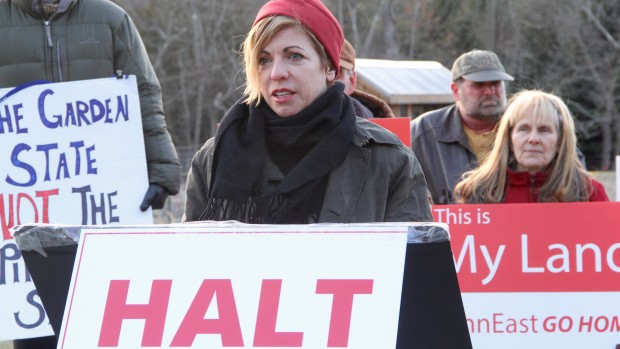FERC urged to take another look at PennEast pipeline plan after route changes
-
Jon Hurdle

Emma Lee / WHYY
Jacqueline Evans, whose farm near Stockton, N.J., lies in the path of the proposed PennEast pipeline, speaks out against the project.
Environmental groups called on Monday for a fresh federal review of a plan to build the controversial PennEast natural gas pipeline from Pennsylvania to New Jersey after newly published route changes cast further doubt on what critics say was already a flawed Draft Environmental Impact Statement by the Federal Energy Regulatory Commission.
PennEast Pipeline Co.’s statement Friday that it plans 33 deviations from its original route highlights the need for another assessment of whether the pipeline would damage the environment along its 119-mile route from Luzerne County, Pennsylvania to Mercer County, New Jersey, the environmentalists said.
Maya van Rossum, who heads Delaware Riverkeeper Network (DRN), said the route changes raise more questions about the credibility of the DEIS which she called “deficient and misleading” when it was issued in July.
“These 33 new modifications further demonstrate that the draft EIS released does not even describe, let alone analyze, the pipeline PennEast wants to build,” van Rossum said in a statement. “FERC needs to go back to the drawing board and issue a new DEIS and hold a new public process, one that includes real public hearings.”
In March, DRN sued FERC in federal court, accusing it of corruption and bias in favor of the gas industry. It said the agency has approved every pipeline application that has come before it since 1986, and that it will not deny projects because it recovers its operating costs through the fees its charges to the industries it regulates.
Pat Kornick, a spokeswoman for the company, said the route changes – 26 of which would be in Pennsylvania’s Luzerne, Carbon and Northampton Counties – are part of an effort to reduce impacts to endangered species and wetlands and to build the pipeline on existing rights of way.
“PennEast views the modifications as being responsive not only to constructive feedback provided by landowners, agencies, and other stakeholders, but also to recommendations contained within FERC’s Draft Environmental Impact Statement,” Kornick said.
In Luzerne County, the route changes would include co-locating the pipeline with a Williams-Transco line, and moving a meter station to the same site as another operated by UGI Utilities. Elsewhere in Luzerne County, PennEast now wants to reroute the line to avoid a quarry and co-locate it within an easement held by Pennsylvania Power and Light.
In Carbon County, the company is working with the Blue Mountain Ski Resort to build the pipeline on a different ski slope to the one it was originally planned for, to avoid a hang-gliding area and existing underground infrastructure.
The changes do not “materially” affect the route, and do not impact new landowners, so they will not need an additional review by FERC, Kornick said.
Celeste Miller, a spokeswoman for FERC, which regulates interstate pipelines, said the agency is “evaluating the extent of the variations to the route”, and that it is too soon to know whether that will impact the process. Miller declined to comment on claims that the changes further undermine the DEIS.
The statement, at more than 1,100 pages, said there could be some adverse environmental impacts from the project but that they could be mitigated if the company adopts measures proposed by itself and by FERC.
FERC’s public-comment period, which ended on Sept. 5, included a series of hearings at which individual members of the public could deliver their remarks on the pipeline to a FERC official, one-on-one, at several locations in the counties where the pipeline would be built. The EIS is expected to be finalized in December.
Critics who attended the events in August said they were not true public hearings but in fact an effort to stifle debate on the controversial line by a federal agency that is often accused of being a rubber stamp for gas-industry projects.
Accusations that public views are not being taken into account have resurfaced with the publication of the route changes after the public-comment period has ended.
“The idea of publishing a Draft Environmental Impact Statement is to allow the public the opportunity to review it, comment on it, and submit any relevant information that they think could help to address their concerns,” said Mike Helbing, a staff attorney with the environmental group PennFuture. “As it stands now, the public is being deprived of the opportunity to do that because all of these changes are being made after the public comment period closed.”
Helbing said FERC should now publish a supplemental EIS that would include its review of the proposed route changes and take into account concerns expressed by critics that he said were omitted from the original document.
Since the DEIS was published in July 22, FERC has come under additional pressure from the U.S. Environmental Protection Agency, which said in mid-September that it had “significant concerns” about FERC’s analysis of alternatives to the project, which it is required to conduct under the National Environmental Policy Act (NEPA), in order to show that PennEast’s preferred option is the most suitable.
“Without additional analysis of alternatives, it is not clear that the preferred alternative is the only one that can meet the stated purpose and need,” the EPA said, in a letter to FERC.
On Sept. 12, the New Jersey Department of Environmental Protection said it could not fully comment on the DEIS because of a shortage of specific technical information about PennEast’s plans. The agency said it had not received any applications for permits on land use or water quality for the project.
















